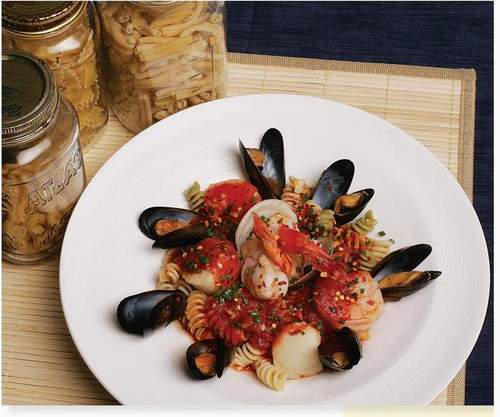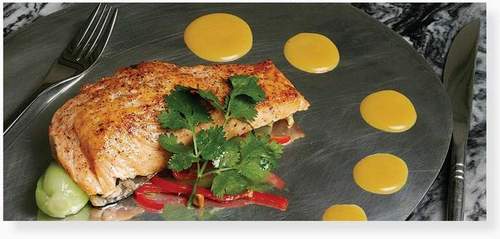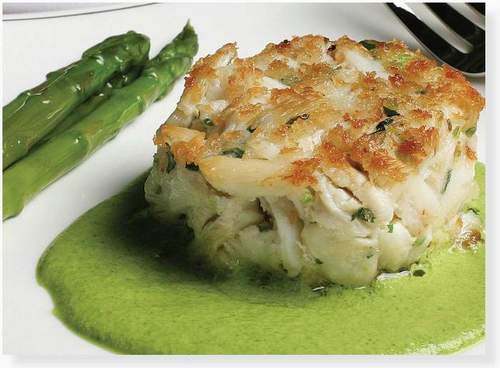Mission: Cook! (20 page)

You cannot go into a family-style Italian restaurant without seeing a variation of this dish on the menu, and many folks remember when they first jumped off the spaghetti and meatballs and had their first Fra Diavolo. It is easy to make at home, and you can pair it with any kind of pasta. I used a tricolor penne because I think the colors are visually interesting, but the explosive flavors, inspired by “the devil in the dish,” remain.
SERVES
6
FOR THE SEAFOOD FRA DIAVOLO
¼ cup olive oil
1 dozen U/15 shrimp (a per-pound count of under 15 shrimp per pound)
1 dozen U/10 or 10/20 scallops (a per-pound count of under 10 scallops per pound or 10 to 20 scallops per pound)
12 top neck clams
12 mussels, cleaned
¼ cup white wine
2 tablespoons crushed red pepper flakes
1 tablespoon garlic, chopped
1 tablespoon chopped fresh basil
2 tablespoons chopped fresh parsley
4 cups marinara sauce
2 teaspoons salt
2 teaspoons pepper
1 pound tricolor penne pasta

Start
a pot of water to boil for the pasta.
In a large sauté pan, heat the oil and sauté the shrimp and scallops. Add the clams and mussels, then the white wine. Add the pepper flakes, garlic, basil,
parsley, and marinara sauce. Season with salt and pepper. Do not overcook the seafood. The shrimp should be cooked just until pink, and the scallops should be cooked just until opaque. Discard any clams or mussels that do not open.
Salt the boiling water for the pasta and cook the penne al dente.
PRESENTATION
In a large serving bowl or platter, place the pasta on the bottom, and arrange the seafood on top. Ladle the sauce over the pasta. Garnish with chopped parsley.
A Note on Shrimp and Scallops
Shrimp and scallops are sold by count per pound. Therefore, the larger they are, the lower the count per pound. The “U” designates the word “under.” In terms of size, U/15 shrimp would mean there is a “count” of fewer than 15 shrimp in a pound. 10/20 scallops would have a count of 10 to 20 in a pound.
T
HE PHYSICAL AND EMOTIONAL CIRCUMSTANCES SURROUNDING THE CRE
ation and serving of food also contribute to the perception of flavor. If you are afraid, if you are in a hurry, at a pressure-packed business lunch or a romantic dinner for two, if you just came in out of the heat or the cold, the same food can taste different depending on the context. I am sure the taste experience of the multitude of refugees in South Yemen will differ drastically from your experience at home when you sample my rice and beans. The sound of shelling and the associated surge of adrenaline had to have made a difference.
If at all possible, I like to talk to people I am cooking for, get acquainted, have a laugh, build a rapport, and put them at ease. It makes the food taste better. That is why good restaurants seek the vital element of control, not only over the food but the colors, the linens, the music, the lighting, the mien of the service people that you will encounter at every stage of your dining experience. (And, of course, location, location, locationâ¦)
As a general guide to the world of flavor and in choosing its building blocks in your preparations, the closer you are to the source of the flavor, the better. Natural sugars from fresh fruits, honey, and molasses, and natural cane sugars are generally better than those that are heavily processed, although those have a place in the modern kitchen in moderation. Sea salt,
fleur de sel,
and kosher salt are generally preferable to iodized salt, and anchovies, caper berries, oysters, sea urchins are all naturally salty items that can steer your flavor profiles in that direction. Bitter, pungent, and astringent flavor effects are more easily and simply achieved through the use of natural products. There is a level of manufacturing to intensify the umami flavor, especially through the use of fermentation, but in general, the Asian cuisines in which it is most prominently featured have a high inherent regard for natural sources of flavor. In this regard, I would only warn against the use of monosodium glutamate, which in my opinion stinks out loud as an ingredient.
The study of flavor is all about balance, in your overall diet, on a menu, on the plate, and right down to each individual bite and swallow. I would love it if you would make and taste all of the following recipes and really consider the elements of flavor as you eat each one. They contain many elements of everything we have discussed so far: the boldness of the color surrounding the whiteness of the crab cakes; the bitter bite of the bok choy and the crunch of the cashews; the encompassing richness of the olive oil surrounding the savory tuna; the evocative gaminess of the duck settled in the
comfort of the ragout, its flavorful essence teased even further by the addition of truffles.
What are the relationships between sweet and sour, hot and cold, spiciness and texture, and what is the cumulative effect on the palate and the
mind
of the diner both during and after the experience of eating these dishes? Be careful with your answers; you may be graded later.
SERVES
8
1 teaspoon ground ginger
Salt and freshly ground black pepper
Eight 4- to 5-ounce salmon fillets
4 tablespoons peanut oil (use canola oil if allergic to peanut oil)
1
/
8
cup orange juice
1
/
8
cup soy sauce (low salt)
6 bunches baby bok choy
¼ cup cashews
2 red bell peppers, cut into julienne strips
2 bunches scallions, cut on the bias
½ teaspoon crushed red pepper flakes
A well-rounded entrée that encompasses most of the essential flavors: sweet (in the fish); sour (in the citric acid); salt (in the soy sauce); bitter (in the bok choy); pungent (with the ginger).
Preheat
the oven to 350 degrees.
Mix the ginger powder, salt, and pepper. Season the fish with the mixture.
Heat half of the peanut (or canola) oil in a hot sauté pan and sear the fish golden brown on both sides. As each side of the salmon sears, do not disturb for about 3 to 4 minutes to allow the surface of each side to begin to caramelize.
Place the fish on a baking sheet into the hot 350-degree oven to finish the fish. This will take about 5 minutes. Bring out of the oven to rest.
Whilst the fish is in the oven, use the same hot sauté pan to reduce the orange juice and soy sauce by half until a light, syrupy consistency.
Stir-fry the bok choy, cashews, red peppers, scallions, and red pepper flakes in the orange-soy glaze to create a warm salad.
PRESENTATION
Place the salad on a platter and arrange the fish around it. Drizzle the orangesoy glaze onto the fish and around the bok choy salad.

SERVES
4
FOR THE CRAB CAKES
10 ounces cooked lump Dungeness crabmeat
2 tablespoons finely diced celery
1 tablespoon very finely diced jalapeño pepper (use gloves in handling this)
1 tablespoon chopped fresh flat-leaf parsley leaves
2 teaspoons chopped fresh thyme leaves
Finely grated zest of 1 lemon
½ cup mayonnaise
2 cups panko (Japanese bread crumbs)
2 tablespoons olive oil, for cooking the crab cakes
8 whole crab claws and/or thighs, for plating
Kosher salt and freshly ground black pepper
Extra virgin olive oil
FOR THE ASPARAGUS AND ASPARAGUS VINAIGRETTE
12 to 16 medium-thick asparagus spears, tough ends snapped off and discarded
Salt, for the cooking water
¼ cup loosely packed fresh chervil leaves
¼ teaspoon fine sea salt or kosher salt
3
/
4
cup olive oil
¼ cup extra virgin olive oil
Salt and pepper
FOR THE LEMON VINAIGRETTE
1 Meyer lemon, cut into 8 pieces
2 tablespoons light corn syrup
2 tablespoons champagne vinegar
½ teaspoon kosher salt
1 cup grapeseed oil
"Sweet” crab, “bitter” asparagus, and a “sour” lemon vinaigrette. “Salty” and “astringent” come along for the ride with the seasonings.

Carefully
examine the crabmeat; don't break up the lumps, but make sure there are no bits of shell or cartilage. Gently squeeze with your hands to remove any excess liquid. Be careful; you don't want the mixture to be too dry either. Put the crabmeat into a bowl with the celery, jalapeño, herbs, lemon zest, and mayonnaise. Fold the mixture so that it's just combined and the crab is not broken or mashed. Divide the mixture into 4 portions and shape into cakes that are
about 2 inches in diameter and 1½ inches high. Refrigerate the crab cakes. The crab cakes will be cooked immediately before you serve them. Refer to the instructions below for cooking them.
At this point, prepare the asparagus, asparagus vinaigrette, and lemon vinaigrette.
The asparagus spears will be cooked in shallow, simmering salted water in a sauté pan or skillet. Cook until the spears are barely tender, but still crisp and green, 3 to 6 minutes, depending on size. Drain and immerse in a bowl of ice water to stop the cooking. Drain again, then cut the tips off into uniform 3-inch lengths and set aside. Put the asparagus bottoms into a blender and add the chervil and salt. With the lid securely on the blender and the machine running, add both olive oils in a slow stream through the feeder tube. Blend for 1 minute. Strain through a fine-mesh sieve into a bowl. Taste for seasoning. If necessary, add water to give the vinaigrette a pourable consistency. Set aside in a bowl and wash the blender.
Preheat the oven to 350 degrees for the crab cakes.
To make the lemon vinaigrette, put the Meyer lemon pieces, peel and all, into the blender along with the corn syrup, vinegar, and salt, and puree until smooth. With the lid securely on the blender and the machine running, add the grapeseed oil in a slow stream through the feeder tube. Blend for 1 minute. Strain through a fine-mesh sieve into a bowl. Taste for salt and, if necessary add water to give the vinaigrette a pourable consistency. Set aside.
To cook the crab cakes, pat the panko onto the tops and bottoms of the crab cakes, then heat the olive oil over medium-high heat in an ovenproof skillet. Add the crab cakes and cook for about 2 minutes, or until golden on one side. Flip the cakes over and put the skillet into the oven for 3 minutes to brown the bottom sides.